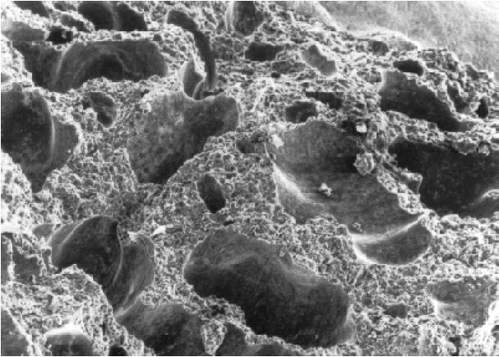The Wheat Industry - Process
Página 1 de 1.
 The Wheat Industry - Process
The Wheat Industry - Process

Fermented dough: large gas holes lined with gluten
Cereals have been of great significance in human history, usually being the first crop to be grown (rather than gathered from the wild) and being the staple food of virtually all people groups until the present day. In New Zealand, the most significant cereal is wheat, which was introduced to New Zealand in the early 1800’s. Wheat is used in the production of
products as diverse as glue, licorice and ice cream cones, but most commonly it is ground to extract flour which is then used in baking - particularly the baking of bread.
The structure of flour
Flour is basically composed of starch and gluten, with small amounts of water, fat, vitamins, minerals and enzymes also mixed in. Starch is a carbohydrate (substance composed of carbon, hydrogen and oxygen) composed of glucose molecules linked together. By boiling with acid, or when attacked by enzymes called α-amylases, starch is converted back to glucose molecules. In bread, this reaction is crucial as the α-amylases naturally present in flour produce the glucose on which the yeast feeds. Gluten is a protein (substance composed of particular acids known as amino acids), and it forms a lattice in bread that holds it in its shape during baking.
Bread making
Bread consists of flour, water and yeast with flavouring agents (such as salt and sugar), preservatives (often vinegar), substances that alter the texture (such as milk) and agents that catalyse the chemical reactions occuring (e.g. malt flour). Often a single ingredient performs several of these functions.
The most significant chemical reaction in bread baking is the CO2-producing reaction caused by yeast feeding on sugar:
C6H12O6 + 6O2 →yeast→ 6CO2 + 6H2O + energy
glucose + oxygen → →→carbon dioxide + water
The energy released helps the yeast to continue growing, and the carbon dioxide is the gas that causes the bread to expand. The kneading of the dough helps to produce bubbles of equal size evenly distributed throughout the dough.
During baking several important chemical changes take place. The enzymes form sugar which initially is used by the yeast for food, and later browns to form the bread crust. More gas is formed, and both the starch and the gluten stiffen to form a solid network base for the bread. During this time the outside of the loaf can rise to over 200oC.
Bread is an important food in that it is a good source of carbohydrate, fibre, protein, B group vitamins and certain minerals.

 Temas similares
Temas similares» Mass Flow ♦ Video Tutorial ♦ Process Industry Informer
» Industry Food Processing - Brewing - Science and Practice
» Allergen Management in the Food Industry edited by Joyce I. Boye and Samuel Benrejer-Godefroy
» [pedido] Process Control, T. E. Marlin
» stephanoupolos CHEMICAL PROCESS CONTROL
» Industry Food Processing - Brewing - Science and Practice
» Allergen Management in the Food Industry edited by Joyce I. Boye and Samuel Benrejer-Godefroy
» [pedido] Process Control, T. E. Marlin
» stephanoupolos CHEMICAL PROCESS CONTROL
Página 1 de 1.
Permisos de este foro:
No puedes responder a temas en este foro.
 Índice
Índice

